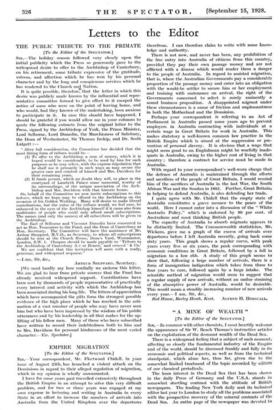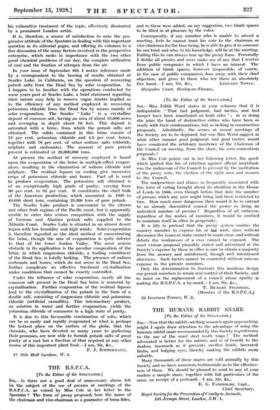A MINE OF WEALTH " [To the Editor of the
SPECTATOR.] SIR,—In common with other chemists, I most heartily welcome the appearance of Sir W. Beach Thomas's instructive articles on the exploitation of the dormant wealth of the Dead Sea.
There is a widespread feeling that a subject of such moment; affecting so closely the fundamental industry of the Empire and of the world, should be discussed frankly and fully in its economic and political aspects, as well as from the technical standpoint, which alone has, thus far, given rise to the somewhat limited treatment of the topic accorded by editors of our chemical periodicals.
The keen interest in the Dead Sea that has been shown in the daily Press of Germany and the U.S.A. stands in somewhat startling contrast with the attitude of British newspapers. The leading New York daily sent its technical editor last year to London to study all the problems associated with the prospective recovery of the mineral contents of the Dead Sea. An entire page of the newspaper was -devoted to
his exhaustive treatment of the topic, effectively illustrated by a prominent London artist.
It is, therefore, a source of satisfaction to note the pro- gressive attitude of the Spectator in dealing with this important question in its editorial pages, and offering its columns to a free discussion of the many factors involved in the prospective enterprise, which ranks in importance with the two other great chemical problems of our day, the complete utilization of coal and the fixation of nitrogen from the air.
In your issue of September 8th I notice reference made by a correspondent to the bearing of results obtained at Searles Lake, in California, on the question of recovering potash salts from the Dead Sea by solar evaporation. As I happen to be familiar with the operations conducted for some years past at Searles Lake, a brief statement regarding their nature may help to remove vague doubts implied as to the efficiency of any method employed in recovering potassium chloride from the Dead Sea by means mainly of solar evaporation. The Searles Lake " is a crystalline deposit of common salt, having an area of about 13,000 acres and averaging in depth about 70 feet. This deposit is saturated with a brine, from which the potash salts are obtained. The solids contained in this brine consist of 13 per cent. potassium chloride and 4.3 per cent. borax, together with 76 per cent. of other sodium salts (chloride, sulphate and carbonate). The amount of pure potash present is estimated at 20,000,000 tons.
At present the method of recovery employed is based upon the evaporation of the brine in multiple-effect evapor- ators, resulting in the elimination of sodium chloride and sulphate. The residual liquors on cooling give successive crops of potassium chloride and borax. Fuel oil is used to produce evaporation. The potassium salt obtained is of an exceptionally high grade of purity, varying from 90 per cent. to 95 per cent. It constitutes the chief bulk of the American production, which amounted in 1926 to 46,000 short tons, containing 23,300 tons of pure potash.
The Searles Lake product is convenient to the citrons and other fruit regions of the Pacific coast, but is apparently unable to enter into serious competition with the supply of German and Alsatian potash salts supplied to the Atlantic Coast. Searles Lake is situated in an almost desert region with low humidity and high winds. Solar evaporation is therefore regarded as the ideal method of concentrating the brine, though the rate of evaporation is quite inferior to that of the lower Jordan Valley. The most serious obstacle in its application is the peculiar composition of the brine, in which magnesium chloride, a leading constituent of the Dead Sea, is totally lacking. The presence of sodium carbonate and borax, which do not occur in the Dead Sea, further complicate an effective fractional crystallization under conditions that cannot be exactly controlled.
Under the influence of solar evaporation, nearly all the common salt present in the Dead Sea brine is removed by crystallization. Further evaporation of the residual liquors lead to the crystallization of the potash in the form of a double salt, consisting of magnesium chloride and potassium chloride (artificial carnallite). This intermediary product, on solution in water and further evaporation, yields the Potassium chloride of commerce in a high state of purity.
It is due to this favourable combination of salts, which can be so easily and rapidly evaporated at what is perhaps the hottest place on tlie surface of the globe, that the chemists, who have devoted so many years to perfecting their processes, are now able to furnish pOtash salts of great purity at a cost but a fraction of that required at any other aource of this important plant food.—I am, Sir, &c., F. J, Znnwimumdovi.
17 Stile Hall Gardens, W. 4.







































 Previous page
Previous page